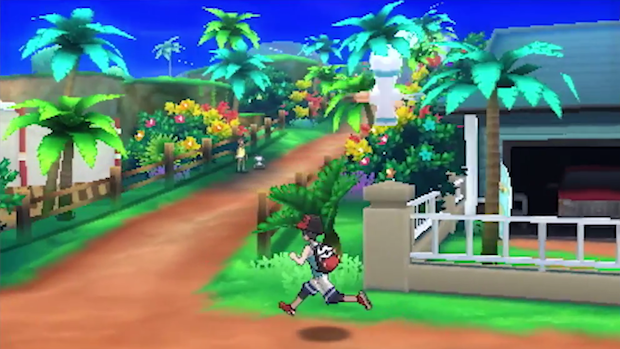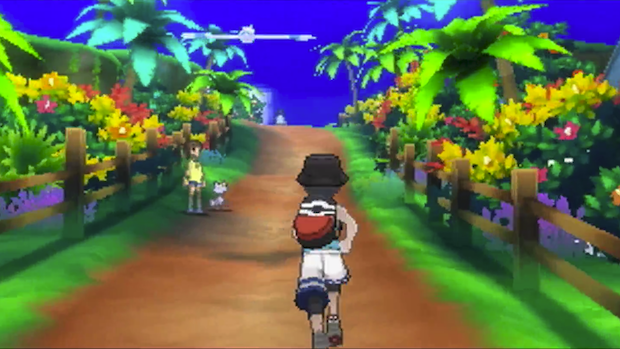
No Pokemon game has ever tried to reshape the formula of the franchise as radically as Pokemon Sun and Moon did. The 2016 RPG made several changes, big and small, that all came together to deliver what is perhaps the most different Pokemon game we’ve played since the series’ inception. Sure, it’s easy to argue that when you really get down to it, even with those changes Sun/Moon felt quite formulaic, but there’s no doubting that some of its biggest changes helped elevate the entire experience to a level the franchise had been unable to reach in the past few years.
Pokemon Ultra Sun and Ultra Moon takes what worked so well in its direct predecessor and it builds upon those strengths in some smart and subtle ways. The end result is a game that isn’t all that different from the series’ first outing in Alola, but is undoubtedly better. It’s also worth noting that that’s only possible because it doesn’t deviate much from last year’s game. Pokemon Ultra Sun and Ultra Moon isn’t the kind of major retelling that other third versions of the series have been in the past (such as Pokemon Platinum), nor is it a direct sequel to the games it is based on (like Black 2 and White 2).
No, this is more in the vein of games such as Pokemon Yellow and Pokemon Crystal. Sun/Moon was already almost the perfect realization of the Pokemon formula, so rather than trying to reinvent the wheel, Ultra Sun and Ultra Moon chooses to build on the rock-solid foundation that its predecessor had already left in place. It gives Sun and Moon the respect it deserves, and makes a number of intelligent changes to elevate the experience to become even better than it was a year ago.
"Pokemon Ultra Sun and Ultra Moon takes what worked so well in its direct predecessor and it builds upon those strengths in some smart and subtle ways. The end result is a game that isn’t all that different from the series’ first outing in Alola, but is undoubtedly better."
For instance, while Sun and Moon was guilty of having a somewhat slow start, Ultra does away with most of what bogged down the opening and kicks things off in a much more interesting way. The story beats themselves are almost identical in the beginning, but the game makes the excellent decision of letting you pick your starting Pokemon almost as soon as you start your adventure. The rest of the beginning plays out almost exactly as it did in Sun and Moon, but this one small change helps with the pacing in a hugely significant way.
Even more significantly altered is the game’s final act. Pokemon Sun/Moon has to be the most story-focused game in the series to date (albeit with stiff competition from Black and White), and Ultra is definitely yet another step in that direction. The addition of several major new characters and events helps make the last third of the game’s narrative feel hugely different from what we saw in Sun and Moon, similar to what we’ve seen in games such as Pokemon Emerald. In fact, it would be fair to say that Pokemon Ultra Sun and Ultra Moon actually does a much better job of telling its story in a cohesive manner than its predecessor did.
Don’t get me wrong, this is still Pokemon, so you shouldn’t expect anything too special or memorable as far as the narrative is concerned. That said, Ultra makes smart changes and additions to its narrative to make it a more complete, more cohesive, and as such, a much more enjoyable tale. Additions such as the Ultra Recon Squad and Ultra Wormholes, for instance, lend another dimension to the entire experience. If you’ve played Sun and Moon before, seeing more of such new elements will be among the several things that will make you want to keep playing.
As significantly altered as the narrative’s final act is, though, the rest of the game is almost disappointingly similar to Pokemon Sun and Moon. For the bulk of my journey, barring a good chunk of half a dozen hours or so at the end, it was hard for me to shake off the strongest sense of deja vu. Given the series’ history with third version releases, I guess I should have expected as much. But after the major deviation that Black 2 and White 2 was from its predecessor, or even Sun/Moon itself was from everything that had come before it, perhaps I was expecting this to be something of a brand new adventure.
"As significantly altered as the narrative’s final act is, though, the rest of the game is almost disappointingly similar to Pokemon Sun and Moon."
Thankfully enough, Pokemon Sun/Moon was a hell of a game, so the fact that Ultra retreads a lot of the same ground kind of works in its favour. The game revolves around the concept of trial challenges rather than gym battles, and going through these while exploring the wonderfully realized Alola, which has to be the best region in any Pokemon game to date, is still as engrossing and addictive as it was a year ago. Trial challenges are notably more enjoyable than they were before, thanks to some design changes made with the intention of making them feel more like puzzles and less like fetch quests (not to mention the fact that there’s a new trial in here as well), and even the boss battles against the Totem Pokemon are a lot more thrilling and challenging than their disappointingly easy Sun and Moon counterparts.
The foundation that Ultra Sun and Ultra Moon is built on is strong enough that it doesn’t need to change much stuff in order to be an enjoyable experience. That said, if you’ve already played Sun/Moon, especially if you did so recently, playing Ultra for an experience that is at least seventy per cent similar (if not more) might not be the best idea in a year that has seen the release of countless other amazing games that deserve your time and attention. By that same token, much of the issues that plagues Sun/Moon are present here as well, which means Ultra Sun and Ultra Moon can feel excessively restrictive and linear at times, and the sense of freedom that characterized Pokemon games in the past is now missing.
It’s due to this almost excessive similarity to the base game that we look to some of the smaller changes in Ultra Sun and Ultra Moon. Fortunately, though, these small changes are actually worth speaking about, and though none of them radically change the way you will experience Alola, they do contribute greatly towards making the experience notably better than it was in Sun and Moon. For instance, while Sun and Moon had one of the best user interfaces we’ve ever seen in a Pokemon game, barring maybe HeartGold/SoulSilver, Ultra makes a few subtle tweaks to make it even smoother- like delegating actions such as saving or throwing Pokeballs at wild Pokemon to a single button press, rather than having to go through entire menus like before.
That’s just one illustration of how Ultra adds in some small but vital features to make an already refined experience even more polished. There’s a lot more of these minor tweaks and variations in the game when you really start looking. Every now and again, you’ll come across wild Pokemon in the overworld that you can play with, from petting them to playing peekaboo with them. Similarly, throughout your journey, your Rotom Pokedex will have a lot more conversations with you than it did in Sun and Moon, and this time, every so often, you’ll actually be able to talk with it through dialogue choices. There’s also Totem stickers lying around every corner of every city and place you visit, and the added hook of collecting these stickers makes exploration even more enjoyable.
"Pokemon Ultra Sun and Ultra Moon adds in some small but vital features to make an already refined experience even more polished."
None of these changes add any actual, new mechanics, nor do they reward players with new items or skills that were previously unseen in Pokemon Sun and Moon, but they do contribute towards making Ultra a much fuller and a much more entertaining package than its predecessor. That’s not to say there are zero new mechanics though- Alola Photo Club and Mantine Surf are new features that were missing from Sun and Moon, and they’re a bit of a hit and miss. Photo Club is surprisingly shallow, and past trying it out once just to see what it was about, I never felt compelled to return to it. Mantine Surf, on the other hand, was an entertaining new mini-game, and I found myself returning to it on more than one occasion.
Pokemon Ultra Sun and Ultra Moon’s visual accomplishments also deserve a special mention. Pokemon Sun/Moon was no technical masterpiece, but it had some gorgeous art, and all around, it has to be among the best looking games you’ll ever see on the 3DS. Ultra Sun and Ultra Moon looks even better, though not hugely so. It polishes some of the rough edges of its predecessor, makes smarter use of lighting, and also uses its camera slightly better- the end result is a game that is beautiful to behold. The soundtrack is also worth a mention here- Pokemon has always been known for having excellent music, and Sun/Moon was no different. Ultra grabs hold of that Hawaiian-themed soundtrack, and with a few variations and a handful of its own additions, it succeeds in making it better.
Game Freak are now working on the next mainline Pokemon game, and surprisingly enough, it’s slated to be a Switch exclusive. Surely, that means that Pokemon Ultra Sun and Ultra Moon is the final Pokemon game we will see on the 3DS. If that is indeed the case, then it’s one hell of a way to say goodbye. It may not be all that different from 2016’s Sun and Moon, making it a little harder to recommend to people who’ve already seen everything Alola has to offer, but for fans of the series, this game is unmissable.
This game was reviewed on Nintendo 3DS.
As addictive as always; More coherent, cohesive story; Beautiful visuals; Amazing soundtrack; Alola is a beautiful and captivating setting; Minor and subtle changes cumulatively make a significant difference; Mantine Surf is a great new mini-game; Trials are more enjoyable than before thanks to some design changes; Boss battles against Totem Pokemon are much more challenging.
Disappointingly similar to Sun/Moon; Alola Photo Club is shallow and unneeded; Just like Sun/Moon itself, it can feel a little too linear at times.



















